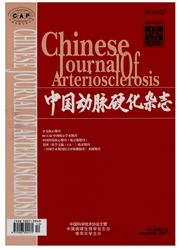

 中文摘要:
中文摘要:
目的观察易卒中型肾血管性高血压大鼠脑动脉的结构变化。方法将易卒中型肾血管性高血压大鼠第4周和8周时处死,脑大动脉切片用HE染色后,测量这些大动脉重塑参数,对免疫组织化学对纤维连接素蛋白表迭进行图象分析。结果易卒中型肾血管性高血压大鼠组血压高于对照组。易卒中型肾血管性高血压大鼠第4周时颈总动脉平滑肌细胞总数(282.5±59.6个)和纤维连接素蛋白表达量(184.3±2.4)较对照组(344.7±50.9个和181.4±3.2)减少,单个细胞面积增加;第8周时,管壁厚度(74.8±12.3邮)、横截面积(233428.3±76487.9时)、壁腔比(0.086±0.007)、壁面积比(0.00030±0.00011)、单个细胞面积(547.9±111.8时)和纤维连接素蛋白表达量(180.8±2.3)均增加,单位面积细胞数(282.5±59.6个)减少。易卒中型肾血管性高血压大鼠基底动脉横截面积第4周和第8周时(15867.4±1316.9府和22556.5±6485.6府)均高于对照组(13598.9±1090.8μm^2),纤维连接素蛋白表达量第8周时(166.2±5.1)增加。第4周时易卒中型肾血管性高血压大鼠大脑中动脉管腔内直径(208.6±59.6μm)增加,壁腔比(0.094±0.048)和壁面积比(0.00150±0.00040)减少;第8周时管壁厚度(23.3±7.2麻)、横截面积(16236,2±6538.4廊)和平滑肌细胞总数(52.2±16.1个)增加,管腔内直径和壁面积比与对照组的差异仍有统计学意义。结论易卒中型肾血管性高血压大鼠不同脑动脉在高血压不同时期的重塑类型和机制存在明显差异,可能是各动脉脑卒中不同的病理基础。
 英文摘要:
英文摘要:
Aim To investigate the difference in the types and mechanisms of vascular remodeling among the different brain arteries. Methods The parameters of vascular remodeling and the smooth muscle cells ( SMC ) were measured through the HE staining photos of the arteries. Protein expression of fibronectin (FN) was determined by immunohistochemistry. Results The amount of SMC and FN expression level in carotid arteries decreased significantly while the SMC average area increased compared with SD at 4 weeks post-operation. At the end of eighth week., there was a significant increase in wall thickhess, wall area, wall-to-lumen diameter ratio, wall-to-area ratio, SMC average area and FN expression level and a decrease in SMC amount d specific area of RHRSP carotid arteries. Wall area in RHRSP basial arteries had been increased since the fourth week post-operation and FN expression increased at the eighth week. There was a significant differece in lumen diamerer, wall- to-lumen diameter ratio and wall-to-area ratio between the middle cerebral arteries of SD and RHRSP (4 or 8 weeks post-operation). The wall thickness, wall area and the SMC amount of RHR middle cerebral arteries were significantly higher than SD at 8 weeks post-operation. Conclusions The difference in the types and mechanisms of vascular remodding in RHRSP brain arteries may be connected with different stroke behavior among them.
 同期刊论文项目
同期刊论文项目
 同项目期刊论文
同项目期刊论文
 期刊信息
期刊信息
